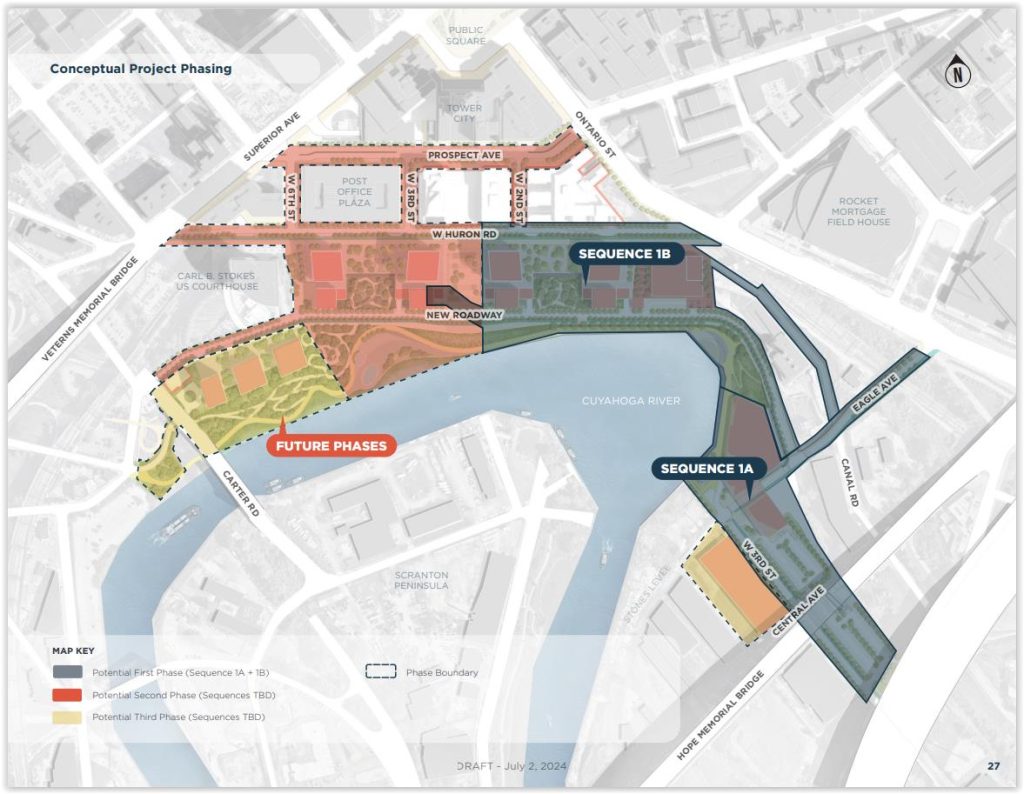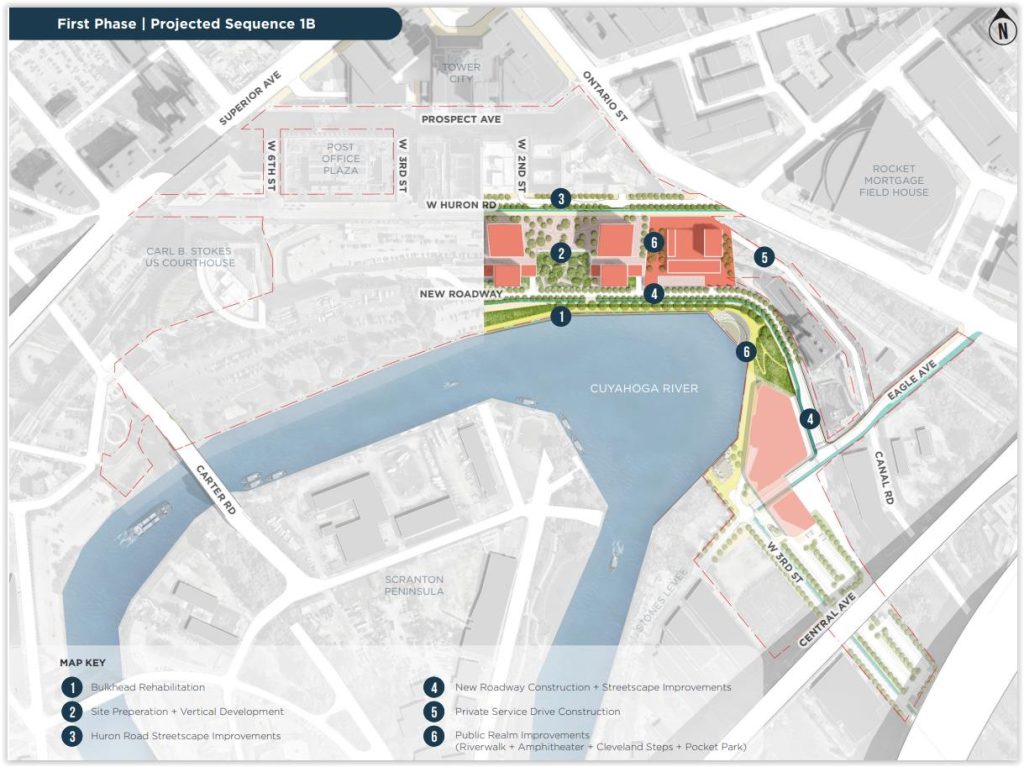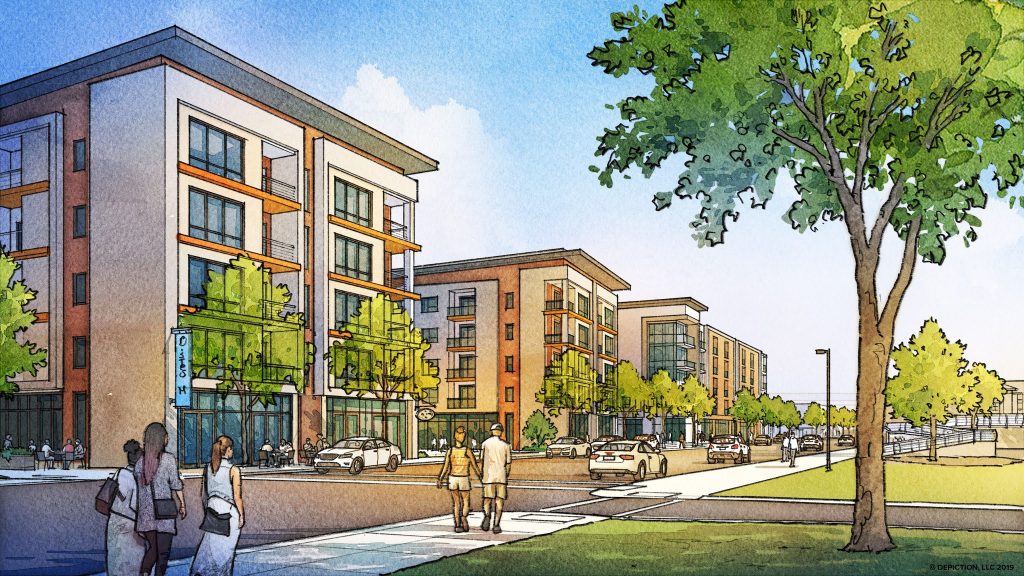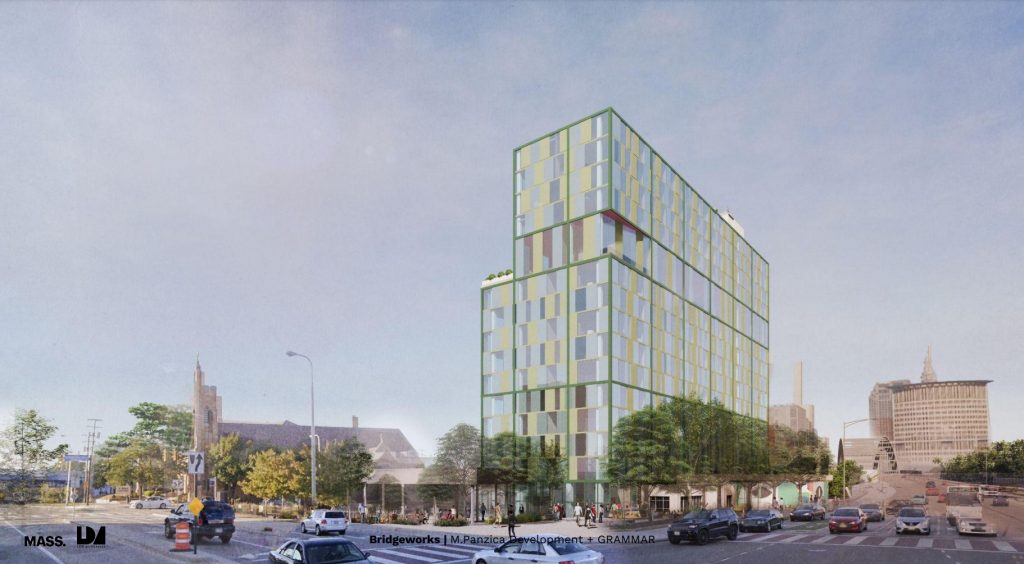
The full build-out of Bedrock’s ambitious $3.5 billion riverfront vision first requires the foundation of infrastructure, public spaces and the creation of development sites for the Detroit-based developer and others to construct their residential, hospitality, office and entertainment buildings (Bedrock-MKSK). CLICK IMAGES TO ENLARGE THEM.
Infrastructure sought to prepare for Phase 1B

On Friday July 12, representatives of Bedrock Real Estate will make a presentation to Cleveland’s City Planning Commission about the upcoming steps they will take to ready the site for their ambitious $3.5 billion riverfront development plan. But a majority of those early steps boil down to just one foundational word — infrastructure.
Of course, there are a lot of descriptions and end products that flow from the generalized term “infrastructure.” They include things like riverside bulkheads, rerouted streets, redesigned streets to become more multimodal, new and rebuilt bridges, walkways, bikeways, parks and open spaces. Those will all be needed to support and sustain the 40-acre development site, Bedrock officials note in their presentation that the city made available to media yesterday.
Actual construction work started on Bedrock’s riverfront last year with the restoration of bulkheads around the outer perimeter of Collision Bend on the Cuyahoga River. Costing nearly $10 million in public and private funds, that work will support the weight of the 210,000-square-foot Cleveland Clinic Global Peak Performance Center for which construction will get underway in the coming months.
By the start of the 2026-27 basketball season, this new riverside center will become the Cleveland Cavaliers basketball team’s new offices and practice facility, relocating from suburban Independence. The Cleveland Clinic also aims to make its portion of the center a global sports science and wellness destination. This facility represents Phase 1A of the riverfront development, plans show.
It was broken out from the rest of the phase one which became Phase 1B for the simple reason that more infrastructure is needed to make this next step happen, which means more money, more work and more time. According to Bedrock’s presentation, Phase 1B has separate buildings for entertainment and hotel/hospitality, mixed-use retail and affordable and market-rate housing, class A office space plus community facilities.
Bedrock says its vision is to “Concentrate density and utilize compact development to promote walkability and create a vibrant and complete neighborhood after each development phase. Increased density and height are encouraged, but the design should consider the existing context, buildings, riverfront views and pedestrians.”
In order for that to be constructed, Detroit-based Bedrock says it needs to ready the site. That’s where the infrastructure comes in.
“The Cuyahoga Riverfront Master Plan is designed to fit within its surroundings and link Cleveland’s Core to the Shore, including the Cuyahoga Riverfront and the Central Business District,” said Bedrock in its presentation. “To establish this, a framework of several critical infrastructure ‘big moves’ are necessary to unlock the site’s potential and prepare it for a 21st-century mixed-use development.”
That means rehabilitate more riverside bulkheads, restore the ramping Eagle Avenue bridge from Ontario Street to West 3rd, extend the existing Canal Road as a service road, and reroute the old Canal Road between the river and Tower City Center as a new riverfront boulevard. Extending the existing Canal Road as service road will be for access by delivery and service vehicles plus parking access.
Those also involve ancillary projects that are no less important. One is to rebuild the Greater Cleveland Regional Transit Authority (GCRTA) decayed track bridge, which is more like a shelf, over the service road. Although it is not specified in Bedrock’s presentation, GCRTA says this construction project could cost about $5.8 million for which federal funding is available but not until 2027.
Another feature to be changed to accommodate the development of Phase 1B is to dismantle and then rebuild the GCRTA Walkway to Gateway from Tower City Center. This enclosed walkway was built by GCRTA 30 years ago to connect its rapid transit station with the then-new sports arena and baseball park of Gateway. Its location and design reportedly complicates the development of buildings envisioned for Phase 1B.
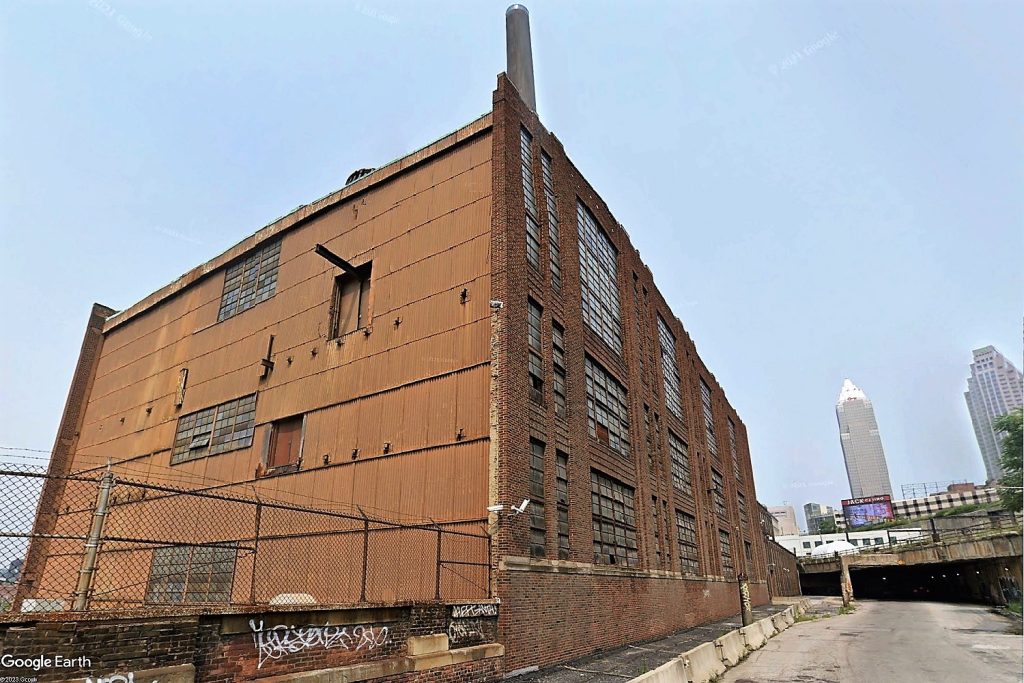
Unresolved in Bedrock’s vision is the fate of Cleveland Thermal’s Canal Road plant. Cleveland Thermal was bought earlier this year by Corix. Canal is to be turned into a service road for Bedrock’s riverfront development. In the background is the Greater Cleveland Regional Transit Authority’s rapid transit bridge over Canal. The bridge is due to be refurbished in 2027 (Google).
Although a total cost for these projects is unknown, it will likely be in the tens of millions of dollars. Funding is anticipated from the city through its urban core tax-increment financing initiative plus state and some federal funds are coming together. In the state’s capital budget approved last week, $10 million was earmarked for Bedrock’s riverfront. Constructing this infrastructure will take several years.
The plan clarifies prior reports that Bedrock intends to demolish Sherwin-Williams’ Breen Technology Center it purchased last year. The global coatings giant plans relocates staff to its new research facilities in Brecksville by the end of this year or early next.
Sherwin-Williams will also relocate its headquarters from the Landmark Office Tower next year. Bedrock, which bought both properties, intends to keep and repurpose the Landmark Office Tower, possibly as residential.
“These comprehensive investments set the foundation for the new parks, plazas, open spaces, multimodal connections, and development-ready construction pads outlined in the plan’s vision,” Bedrock’s presentation added.
The presentation also notes that it is seeking streetscape improvements to Prospect Avenue, Huron Road, West 6th, West 3rd and West 2nd streets at the Tower City level and West 3rd at the river level. These projects will narrow the roadways for vehicular traffic to two lanes in each direction to slow down cars and make them more pedestrian friendly. The availed space is proposed to feature the addition of greenspace and cycle tracks to each.
Remaining infrastructure improvements include improved GCRTA bus and rail access through its downtown hub in Tower City and on Public Square. And Bedrock notes that it intends to develop improved regional bicycle network access to existing and planned trails and lanes.
Bedrock says it will support ongoing and future infrastructure efforts that may align with the riverfront master plan vision. One of those is to include an opportunity to extend the Cuyahoga Valley Scenic Railroad 10 miles north from Rockside Road in Independence to Downtown Cleveland along existing tracks.
The Northeast Ohio Areawide Coordinating Agency (NOACA) has begun a feasibility and engineering study for that extension. Bedrock proposes a station site that is a long walk from any downtown activity centers. NOACA consultants are considering a station site closer to the action, possibly by running alongside old Canal Road to near the vacant Cleveland Thermal plant. The steam heating company was sold earlier this year to micro energy supplier Corix.
A topic which Bedrock’s presentation spends a large chunk of pages on is parks and open space. In fact, more pages — eight in all — are devoted to outlining its vision for parks and open space than any other land use category.
“This conceptual neighborhood will feature a mix of programming with parks, open space, pathways, and the riverfront at every turn,” Bedrock says. “This plentiful and accessible green space along the river draws inspiration from the ‘Forest City.’ A conceptual Riverfront Park and Riverwalk and other pathways weave together a variety of textured, cultured, and equitable public spaces that cater to diverse interests and ages.”
Conceptual park and open space projects may include an amphitheater and Hillside Knoll, the Courtyard Steps and Cleveland Steps, sites called Porch, The Belvedere and Forest Hill, plus a kayak launch and associated plaza as well as a public riverfront park and riverwalk.
Bedrock says the goal of its vision is to “Create an engaging and vibrant streetscape that promotes the pedestrian experience, establishes a distinct sense of place, facilitates multi-modal transportation, and supports the varied public and private parks and open spaces throughout the development.” That includes having activated building frontages, rather than fortress walls, that allow people to interact with buildings via inviting entrances and openings.
END

